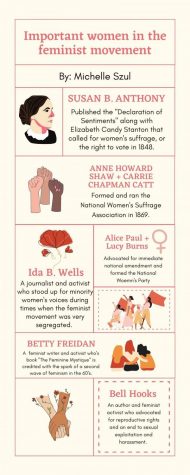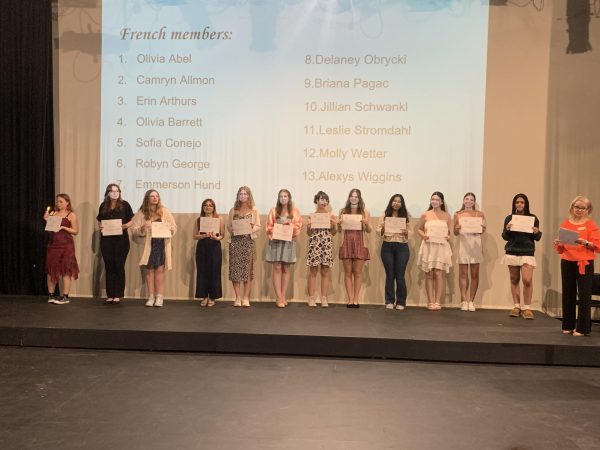The feminist movement evolves over the years
 Feminism has been around in the world for a very long time, across many different countries in different waves. In America, it is recorded that the first wave of feminism began at the Seneca Falls Convention in 1848, where three hundred men and women rallied for equality for women. In today’s day and age, these numbers seem miniscule compared to the estimated millions of people who participated in the Women’s March in 2017 in America alone.
Feminism has been around in the world for a very long time, across many different countries in different waves. In America, it is recorded that the first wave of feminism began at the Seneca Falls Convention in 1848, where three hundred men and women rallied for equality for women. In today’s day and age, these numbers seem miniscule compared to the estimated millions of people who participated in the Women’s March in 2017 in America alone.
The cause of the feminist movement started off about equality for women, and it has taken many different other issues under its wing, such as the wage gap or sexual assault rates. Many great accomplishments have come from the feminist movement, like the 19th Amendment, where women won the right to vote. America has changed for women greatly over time, so while things on paper seem ideally better than it used to be, why is there still a big push for feminism?
“So I think in the last 10 years there has been a big push [for feminism] because of a few things. First, we have a new generation in the workforce (Millennials), and I think they started to ask questions about the status quo- why should women just accept the behavior men put on them? Why is it a woman’s fault if she is harassed or attacked? Women should be in charge of their bodies and should be able to wear what they want. I think a key factor here is it isn’t just women speaking out. Millennial men were also asking these questions. Then you have the #MeToo movement where not only women with agency speaking out; they gave other people permission to speak out,” said Cher Schwartz, English teacher.
While striving to be about equality, feminism has come under fire for being predominantly white, led with many other women who are BIPOC or LGBTQ+ not getting the equality or recognition they deserve.
“When I talk about feminism, I am talking about intersectional: all inclusive to trans, BIPOC, LGBTQ+, straight, non-binary, and cis-gender male and female. All people need to support the diversity that we have to offer and honor and support each population as their needs differ. This means that feminism is more than just shouting “Girl Power,” it needs to be about autonomy, providing all women autonomy over their bodies, protecting all women’s bodies from harassment or violence. It needs to be about providing treatment when traumatic events occur, trusting that law enforcement and the justice system will listen and believe people and their stories and hold aggressors accountable regardless of gender or power or socio-economic status or race, etc,” Schwartz said.
With social media being such a large portion of people’s lives now, it is easier for younger generations to find information on events in the world or find stories on modern feminism.
“Education is critical to all of these movements. Historically, women had been excluded from educational opportunities, and this justified the discrimination that they faced. Many of the women who led the movements used literature to convey and argue their points to the public. Gloria Steinem’s book ‘The Feminine Mystique’ is what launched the Second-Wave Feminist Movement. Education allowed women to enter into diverse and elite fields challenging the assumptions that women were not capable of these positions,” said history teacher Roxanne Bristow.
Education on feminism and on issues women face in the world is important even in the aspect of starting discussions or allowing people to create their own opinions.
“It’s hard for me to say how I feel about feminism because I think it’s hard to separate the performative parts and the genuinely helpful parts. It’s great in theory, but I fail to see sweeping changes result from it. We’re still struggling with the wage gap, sexual assault rates, and period poverty even after decades of articles and campaigning and ‘standing up’ because feminism doesn’t address systemic issues, it just discusses them,” said senior Marina Obaid .“At the end of the day, I think feminism is a stepping stone to a larger goal of gender abolition, a movement that’s appropriate for the society we live in, and people have to be realistic of their expectations of it.”
As awful issues still continue to arise, such as the murder of innocent women, feminism will continue to grow and strive to create at least a discussion on why events like that shouldn’t be normalized. People nowadays may say that protests are unjust, but historically, they have been happening for a very long time.
“Modern protests are in many ways similar to the protests that women used before. Alice Paul and Lucy Burns organized the first March on Washington in 1913. They stood ‘silent sentinels’ outside of the White House for almost two years from 1917-1919 utilizing early foundational documents and President Wilson’s own words as their banners to advocate for women’s suffrage. They were jailed and then beaten during their imprisonment. Eventually, they would be recognized as political prisoners. Today, we see continued protests like the Women’s March which happens in Washington, D.C., but also around the country. The largest change is the use of social media. This is where we see the visibility of movements such as #MeToo. This serves to gain visibility and widespread publicity for major issues,” Bristow said.
Feminism itself is a very broad movement with many different subcategories and people who align themselves with it. What feminism means to you may be different than the next person and the person after that. It’s very clear that this is not a movement that will die down soon, but grow as education and social media reach younger audiences.




